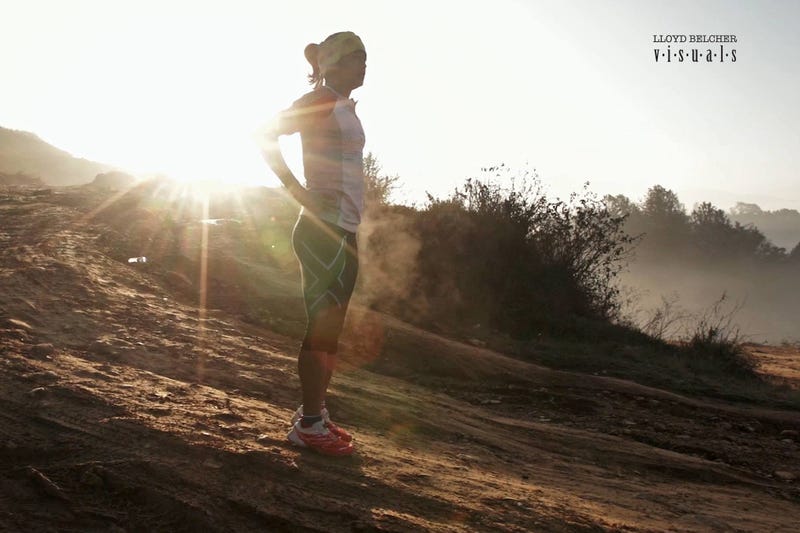
See the steam rising off Nepali mountain runner Mira Rai? Sweet effect, right?
“Well, the truth is that we tried to film the same scene the day before, but Mira was bitten by a wild dog on that hillside & so we had to cut filming short & get her to a clinic in Kathmandu for rabies shots,” filmmaker Lloyd Belcher detailed on his Facebook page.
Belcher writes that Rai rinsed Cujo’s saliva from the shorts when she got home from the clinic. The next morning, dog-bitten, vaccine punctured, and wearing damp lycra, Rai was out at the crack of early to run up and down the hill until Belcher got the right shot. The steam from the still-drying shorts was a happy accident. Aesthetically speaking.
The back story of this image, and the documentary it was a part of, is the story of Rai’s life—things are not what they appear to non-Nepali eyes. What might seem traumatic by American standards is a Thursday morning for Rai. This equanimity is certainly a factor in her breakneck progress from struggling Nepali girl to a close second place in the 2015 World Skyrunning series—a sport, an entire world she didn’t know existed 18 months prior.
Rai is Nepal’s first female sports star to make a name for herself on the world stage, and as such, has become both a national hero and social pioneer.
Call it resilience, patience, acceptance, the Finnish sisu, the Chinese eating bitterness, the Japanese fall seven times, get up eight—whatever you call it, it’s mandatory for Nepalese women. So when a wild dog takes a fancy to your hamstring? Bummer. But that ability to endure life’s hardships and carry on comes at the cost of willingness to take risks. Nepali women tend to be very resilient, but not big risk takers. Who needs to add extra challenge to the daily struggle by swimming upstream of societal norms?
“Certainly, the attitude to sport here is it’s either something done at school, or it’s a luxury, a non-necessity, so anyone trying is going to meet, at best, indifference, and more likely negative comments,” said Richard Bull, founder of Trail Running Nepal, a Kathmandu-based organizer of trail races.
The number of Nepali women imagining an activity they’ve never seen or heard of, that they might be good at, that they’d have to travel to Kathmandu to do, or maybe Italy, is really small. Really small. And that this rare resilient-yet-adventuresome woman would be a world-class talent? Forget it. Needle in a haystack.
On March 22, 2014, Rai showed up at the Himalayan Outdoor Festival 50K (31 miles) trail race, organized by Trail Running Nepal, wearing a cotton t-shirt, track pants, and $3 running shoes. She had no food or water. Her longest run to date had been about 12 miles. Some nine hours later, enlivened by hail and torrential rain, she’d discovered “hilly up-down running,” as she called it. She was the first and only female finisher.
“I got an opportunity and I didn’t want to pass that up,” Rai offered via Skype as the reason for showing up to an event she knew nothing about. Opportunity of any kind is thin on the ground. Wow, good chance I have bubbles up in her conversation frequently, and with it, the onus to use it wisely.
Born 26 years ago in a mud house with no electricity or running water in eastern Nepal, Rai’s life course was already narrowly prescribed.
“Boys are sent to school,” Rai said, through an interpreter (her English skills have improved since then). “Girls are brought up to be sent to someone else’s home for marriage, so they’re not worth the investment. Women are for household things; the big things in life are for men. Then if you’re from a lower caste [Rai are sort of in the middle of the caste ladder] as well, there are no opportunities for anything else.”
Never fond of household chores, Rai looked for opportunities to get outside, whether that meant lugging water buckets back up the hillside, making the two-day trek to the market, or carrying a 62-pound sack of rice over a mountain pass to sell. Her forays outside the village nurtured her independent nature, making her a little more worldly, a little more self-confident, and a lot stronger. So when the Maoist army came recruiting, offering two meals a day (!) and a chance to do something (!) for her country (!), the then-14-year-old joined up.
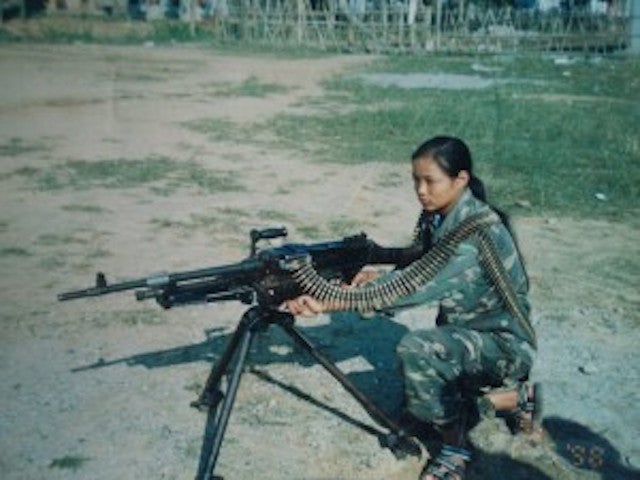
Rai spent two battle-free years with the rebels, enjoying literal boot camp training in karate, calisthenics, and running, sometimes two hours a day over mountain trails. When the Nepalese Civil War ended in 2006, she was once again faced with the limitations of village life. She drifted, going home for a while, sometimes living with friends from her rebel army days, studying a bit of agriculture.
On the verge of going to Malaysia to work in a factory (sometimes a legitimate opportunity, but often a cover for trafficking), her former karate instructor invited Rai to come to Kathmandu to train for road and track running. He’d noticed her strength and endurance while training with the Maoists.
Unable to afford even the small fee for proper training, she was dismissed by running coaches with instructions to go to Kathmandu’s flat, heavily polluted Ring Road, and, well, run. Hopelessly non-specific training advice given to a mediocre road runner. Six unsuccessful months later, she had decided to go back home when some male runners told her about a different kind of race. This was her opportunity—the Himalayan Outdoor Festival trail race, where she was the only female finisher.
Three months later, with a donated kit and crowd-funded support organized by Trail Running Nepal, she won the competitive Mont Blanc 80K trail race in Italy. Her victory in the longest race she’d yet undertaken broke the course record held by trailrunning’s top competitor, Emilie Forsberg.
“I was thinking if I could win that race, while my country was crying [due to the May 2015 earthquakes], I could bring a small bit of happiness,” she told Asia Trail magazine afterward. Mission accomplished: Her victory made the front page of Nepal’s daily newspapers, a bright spot in otherwise dark times.
She continued with this breathless race report:
“I was running with Hillary [Allen], just staying behind. I took it a bit easily. Really enjoyed. Wow, check points they have fruit, everything, to eat,” she said, making a mouth-filling motion with both hands. “You can drink so much you have to spit it out! Near every check point—‘Allez allez,’ ‘Dai dai,’ cow bells tung tung tung. I am ‘Hello, hi everybody.’ At 65km, I said ‘Let’s go, Hillary’ and started a little bit fast. First sister [Anna Comet Pascua of Spain] was walking hands on legs. I am just walking normally, and passed her. I met Greg [Vollet, of team Salomon] at 70km. ‘Wow Mira, you are very strong,’ Greg said. OK, I will try. Bye-bye Greg brother, then I am going, and I ran hard.”
With an ambitious schedule of eleven competitive races in 2015, she racked up six wins and a second place finish in the Skyrunning World Series—trail races that combine distance, high altitude and technical terrain. Trail running having no set definition—flat trails, paved trails, mountain trails, ultras—and being loosely organized, it’s hard to accurately rank competitors, but it’s safe to say that, 18 months after her very first race, Rai ended 2015 as one of the top five trailrunners in the world.
Rai trains five to six hours per day for races featuring odometer-spinning mileage, lung-searing altitude, and leg-snapping terrain. She’s competing against the best in the world, and often navigating international travel in an unfamiliar language. I once asked her what she found most difficult about the sport. She was completely stumped. She’d clearly never thought of any part of the endeavor as difficult.
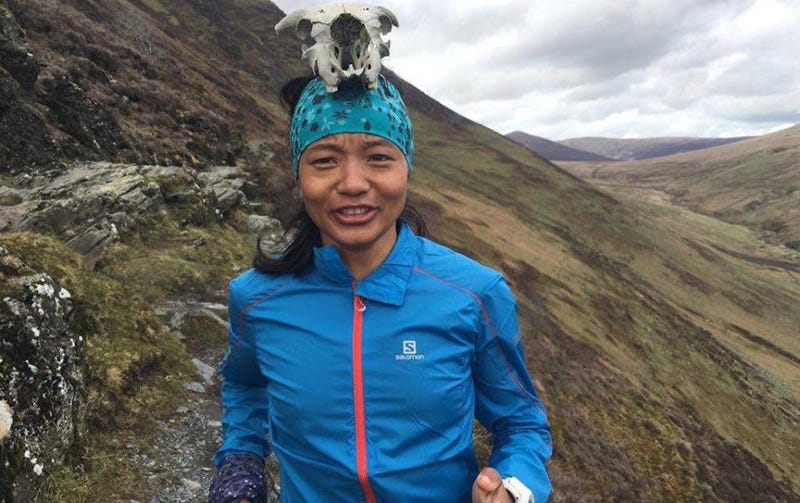
Because of her sponsorship, winnings, and support from the trailrunning community, Rai has been able to stay in Europe for the entire 2016 season, April through September, and has already earned more than most Nepali women will in their entire lifetimes. Still, her goals are more inspirational than personal.
“My hope is to help sisters and to influence Nepali women, to say that we have power as well, and we can do anything,” Rai told Asia Trail magazine.
Richard Bull of Trail Running Nepal doesn’t have hard data, but reports that he sees more women and girls turning up for trail races in Nepal. He thinks it’s probably a result of a combination of Rai’s influence, more trail races in general, better marketing, and help with training. “So far, that’s only happening piecemeal in specific localities where there is a motivated person to organize things,” he said.
To be clear, when he talks about training, Rai-style practical preparation still reigns, as shown by photos Bull sent of eager newcomer Sunita Giri training:
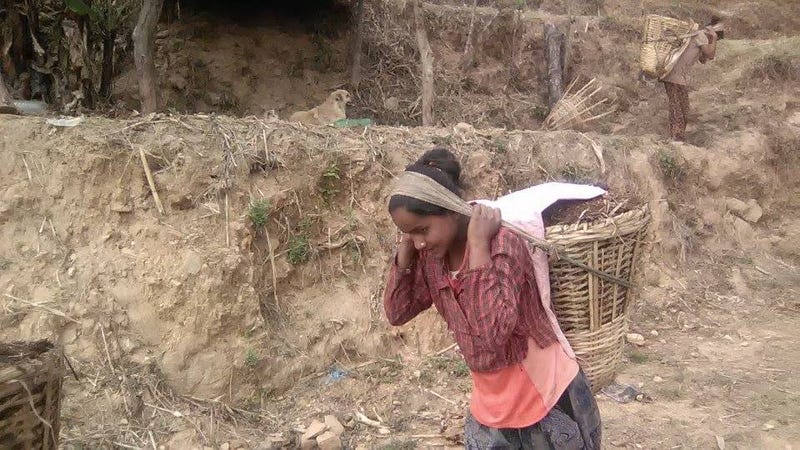
And after a competition (yes, those are her racing flats):
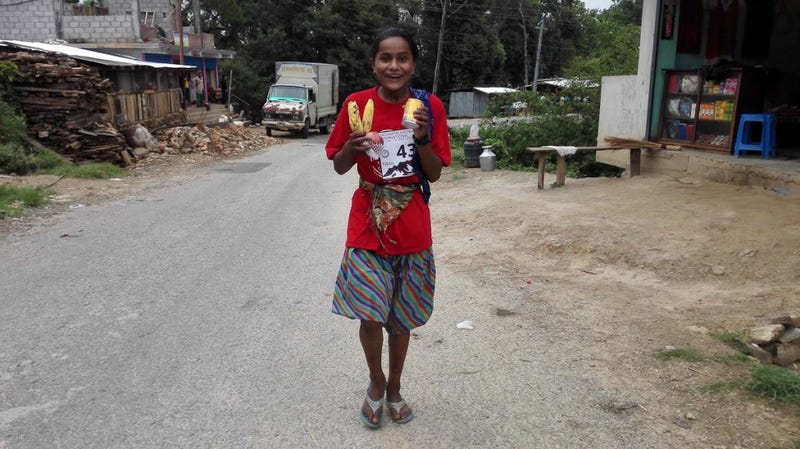
Despite a promising hometown showing, above, Sunita’s father refused to let her travel to Kathmandu for another race. One step forward, half step back.
Putting one foot in front of another is what Nepali women do though, whether it’s in a dusty village or the fan-lined trails of Europe’s most competitive races. Rai starts the 2016 season at the 3 Peaks Race in the UK on April 30, and will follow the Skyrunning Series with a race per month through the championship in Spain on September 24.



